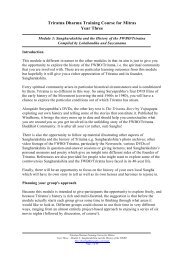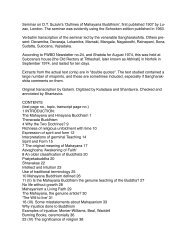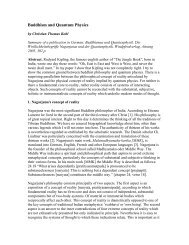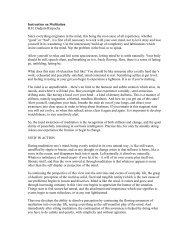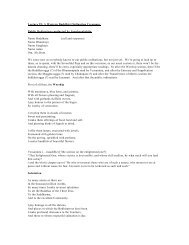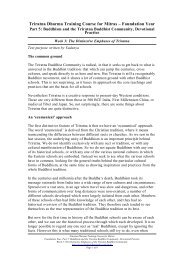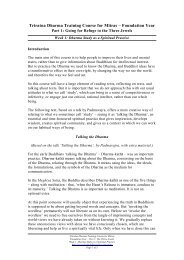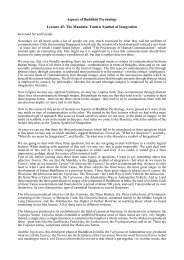Great Buddhists from Triratna Refuge Tree - Free Buddhist Audio
Great Buddhists from Triratna Refuge Tree - Free Buddhist Audio
Great Buddhists from Triratna Refuge Tree - Free Buddhist Audio
Create successful ePaper yourself
Turn your PDF publications into a flip-book with our unique Google optimized e-Paper software.
He then describes how, having had an initiation of Padmasambhava <strong>from</strong> Khachu<br />
Rimpoche, he came across a xylograph of the Tharpe Delam, a Nyingmapa text, in<br />
the Kalimpong bazaar, which contains the Four Mula Yogas in the Nyingmapa<br />
tradition. With more instruction <strong>from</strong> Khachu Rimpoche, he took up this practice.<br />
Although he could do the practice for only two years because he then returned to<br />
England, he states: “I had a more intense and more sustained experience of Going<br />
for <strong>Refuge</strong> than ever before,” and later he says that by undertaking the practice and<br />
becoming deeply absorbed in the experience of Going for <strong>Refuge</strong>, it becomes, “No<br />
longer possible... to think of the Going for <strong>Refuge</strong> and Prostration Practice simply<br />
as one of the four mula yogas, or of the act of Going for <strong>Refuge</strong> itself simply as a<br />
means to the arising of the Bodhicitta,”, so the practice becomes, “A spiritual<br />
practice in its own right.” He adds that the Going for <strong>Refuge</strong> and Prostration<br />
Practice represents, “A transposition of the act of Going for <strong>Refuge</strong> into the rich<br />
and colourful mode of the Indo-Tibetan Tantric tradition. As such, it also<br />
[represents] a restoration of Going for <strong>Refuge</strong> to something like its original place<br />
in Buddhism and in the <strong>Buddhist</strong> life.” I shall return to some of these points later.<br />
I shall now examine how the Going for <strong>Refuge</strong> and Prostration Practice of<br />
Śākyamuni, in the form that we have been doing it, came about in the <strong>Triratna</strong><br />
<strong>Buddhist</strong> Order and in the <strong>Triratna</strong> <strong>Buddhist</strong> Community.<br />
The Padmasambhava prostration practice, of course, came through Bhante. He<br />
gave that practice to certain Order Members many years ago, and individual Order<br />
Members took it up. Some Order Members have done the 100,000 prostrations in<br />
that practice. It became quite popular in the late 1970s. On the Vine Hall 1978<br />
Order Convention we did the practice collectively every day.<br />
Thus a good many people took up that form of the practice. In the last few years,<br />
however, particularly in what is known as the new Men‟s Ordination Process,<br />
Subhuti and the team presumably felt that, in order to enable Mitras to deepen<br />
their Going for <strong>Refuge</strong>, it would be good for them too to take up the Going for<br />
<strong>Refuge</strong> and Prostration Practice, and the practice they adopted was the Going for<br />
<strong>Refuge</strong> and Prostration Practice of Padmasambhava. We also introduced this<br />
practice into the Women‟s Process. Eventually Subhuti began to feel that it was no<br />
longer completely appropriate for the people doing it. It is interesting that that<br />
decision did not arise in a superficial way. It was not a case of, “Oh, let‟s change<br />
the practice”, or “This isn‟t working.” I think that the Padmasambhava practice<br />
was really explored. Subhuti himself produced talks called The Mythic Dimension,<br />
and Aloka produced a booklet on the Prostration Practice of Padmasambhava<br />
which went into it in very great detail. It was as a result of quite a deep<br />
exploration of doing that practice on successive Going for <strong>Refuge</strong> retreats, for the<br />
purpose of helping Mitras and Order Members deepen their Going for <strong>Refuge</strong>, that<br />
Subhuti came to feel that it was not entirely appropriate.<br />
There were a number of reasons for that feeling. In the first place, not everybody<br />
felt a connection with Padmasambhava. Some people have a response to Tibetan<br />
Buddhism very early on – that is the kind of Buddhism that they are interested in –<br />
so those people would enjoy particularly that practice with all its detailed Tantric<br />
figures. But not everybody felt that connection. Furthermore, it is a practice <strong>from</strong><br />
<strong>Triratna</strong> Dharma Training Course for Mitras<br />
Year Four, Module 7: <strong>Great</strong> <strong><strong>Buddhist</strong>s</strong> <strong>from</strong> the <strong>Refuge</strong> <strong>Tree</strong> of the <strong>Triratna</strong> <strong>Buddhist</strong> Order<br />
http://freebuddhistaudio.com/study<br />
Page 26 of 42



